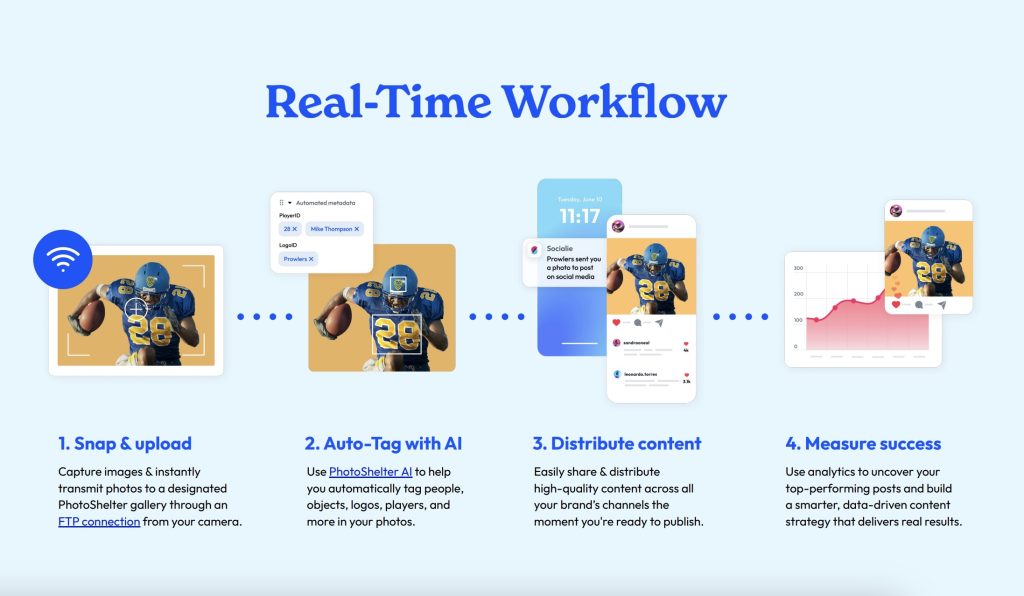PhotoShelter is a company that provides software for digital asset management (DAM), allowing organizations to organize, store, and share their visual content, such as photos and videos. The platform utilizes AI for tasks such as image tagging and video transcription, providing solutions for professionals and businesses to manage creative assets, streamline workflows, and efficiently deliver content to their audiences. Pulse 2.0 interviewed PhotoShelter CEO Andrew Fingerman to gain a deeper understanding of the company.
Andrew Fingerman’s Background

Could you tell me more about your background? Fingerman said:
“I’ve spent over two decades in marketing and digital media with a passion for how tech can empower visual storytelling. I joined PhotoShelter over 15 years ago, first leading marketing. Today, as CEO, I have the privilege of helping some of the world’s most beloved organizations – from major sports leagues to universities and global brands – manage and share their digital content more effectively.”
Formation Of The Company
How did the idea for the company come together? Fingerman shared:
“Early on, our founders were obsessed with using emerging cloud technology to make life easier for the working creative professional – they started by building a robust system that could safely store, manage, access and distribute creative content for individuals and teams. That initial concept – using innovative tech to help creative people thrive – has remained core to our team’s DNA as we have evolved our platform alongside the rise of real-time, visual first communication for the world’s most savvy brands.”
Core Products

What are the company’s core products and features? Fingerman explained:
“Our flagship offering is our Digital Asset Management (DAM) platform, designed to help creative teams organize, collaborate on, securely store and distribute visual content – like photos, videos, graphics – at speed and scale. We’re known for our intuitive interface, real-time collaboration tools, AI-powered tagging and search that makes finding the perfect asset a breeze.”
Challenges Faced
Have you faced any challenges in your sector of work recently? Fingerman acknowledged:
“One big challenge is the sheer volume of content being created now, especially with the explosion of short-form video and user-generated content. But beyond volume, the way people want to see and consume content is changing constantly. Everything is moving faster. Audiences are engaging across more platforms, in different formats, and with increasingly high expectations for speed and personalization.”
“As a result, our customers are under pressure to not only produce more content, but to deliver it in the right way, at the right time, to the right audience. That’s a big ask. To stay ahead, we’ve leaned into automation: smarter metadata, AI-powered tagging, and tighter integrations with the tools our customers already use. Our goal is to simplify the complexity and help them move at the pace of modern storytelling without sacrificing quality or brand consistency.”
Evolution Of The Company’s Technology
How has the company’s technology evolved since launching? Fingerman noted:
“When we started, we were helping individual photographers store, manage and sell their work. Today, we’re powering enterprise content engines for global brands. We’ve expanded into video, introduced AI capabilities, and developed an open API so our platform can plug into the full content workflow.”
Evolving Fan Engagement
How are you seeing fan engagement evolve in today’s digital landscape, especially with the rise of user-generated content and social media platforms like TikTok? Fingerman pointed out:
“The shift has been seismic. Fans don’t just want to consume content anymore, they want to participate in it. Whether it’s submitting photos, sharing their game-day experience on TikTok, or being featured in branded content, fans are an integral part of the story now. The smartest teams and leagues are recognizing that fan engagement is no longer one-way: it’s collaborative, it’s visual, and it’s real-time.”
Helping Sports Organizations With Fan-Driven Content Experiences
How is PhotoShelter helping sports organizations adapt to and lead in this shift toward participatory, fan-driven content experiences? Fingerman noted:
We’re building tools that make it easy to incorporate user-generated and influencer content into an organization’s media workflow without sacrificing speed, quality, or brand control. For example, our platform allows teams to instantly upload and categorize content from photographers, influencers, or even fans – in the stands or across the globe. That content can be reviewed, approved, and published to social within minutes, keeping brands relevant, responsive, and ahead of the curve.
Significant Milestones
What have been some of the company’s most significant milestones? Fingerman cited:
“Some recent milestones I’m especially proud of:
- Supporting the largest leagues in the world (like NFL, MLB, UFC, and NBA) with content workflows that enable faster fan engagement
- Launching our AI Visual Search and Smart Galleries to improve content discovery
- Growing to manage more than 5 billion assets across our platforms – an incredible testament to the trust our customers place in us”
Customer Success Stories
Can you share any specific customer success stories? Fingerman highlighted:
“Absolutely. The Philadelphia Eagles completely reimagined their content distribution using PhotoShelter. During live games, their creative team uses our tools to upload and distribute visuals in real time, boosting their social media presence and deepening their fan connection. Our content workflow tools enable lightning fast sharing right as the game is unfolding, while our social distribution capabilities ensure their entire ecosystem is able to share that content to amplify the Eagles brand. And our analytics tell the Eagles exactly how that’s working. It’s a great example of what’s possible when the right content is delivered at the right moment.”
Revenue
Are you able to discuss revenue? Fingerman revealed:
“We’re privately held and don’t disclose revenue figures, but I can share that we’re consistently profitable and growing year-over-year. We’ve also made several strategic acquisitions to accelerate our capabilities.”
Total Addressable Market
What total addressable market (TAM) size is the company pursuing? Fingerman assessed:
“We see an addressable market of $8 billion when you consider the global need for content management and distribution in media, sports, education, corporate communications, and beyond. As the volume of visual content grows, so does the urgency for scalable, intelligent DAM solutions.”
Differentiation From The Competition
What differentiates the company from its competition? Fingerman affirmed:
“We’re purpose-built for visual storytelling. Unlike legacy DAMs that treat creative assets like just another file type, we prioritize visual speed, searchability, and usability. We know our tools make PhotoShelter the fastest option for real-time content management and distribution, which enables us to offer our customers more than simply delivering on the standard DAM value proposition. Also, our customer success model is best-in-class. We work as a true partner to creative and marketing teams to get the most out of the platform, while managing an enormous volume of content at scale.”
Future Company Goals
What are some of the future company goals? Fingerman emphasized:
“We’re focused on three things:
- Deepening our AI capabilities to make content even more discoverable and usable
- Expanding our footprint in industries like sports, education, and corporate comms
- Continuing to reduce the time it takes for an idea to become a published piece of content, by enabling our customers to work smarter and faster with our tools”
Additional Thoughts
Any other topics you would like to discuss? Fingerman concluded:
“One thing we’ve been thinking about a lot lately is how fan engagement is becoming more visual, more personal, and way more interactive. Fans don’t just want to watch anymore, they want to participate. They want to feel like part of the story, whether that’s through reposting a behind-the-scenes moment, getting exclusive content that hits their inbox during a game, or seeing their own photos or reactions show up in a team’s social feed.”
“That shift, from “watching” to “contributing,” is changing how teams and organizations think about content. And because of that, the bar is so much higher, which ultimately is what drives our product roadmap. Everything has to be faster, more platform-specific, and more emotionally resonant.”
“It’s also getting more complex. The ways people consume content are constantly changing – short-form, long-form, vertical, horizontal, real-time, nostalgic throwbacks, and all across different channels. We’ve had to be really thoughtful about how we navigate that, how we prioritize what gets shared where, and how to keep things feeling authentic and not just like content for content’s sake.”
“The future of fan engagement is going to be built on meaningful visual storytelling. And the organizations that really understand how to make people feel something are the ones that will stand out.”


